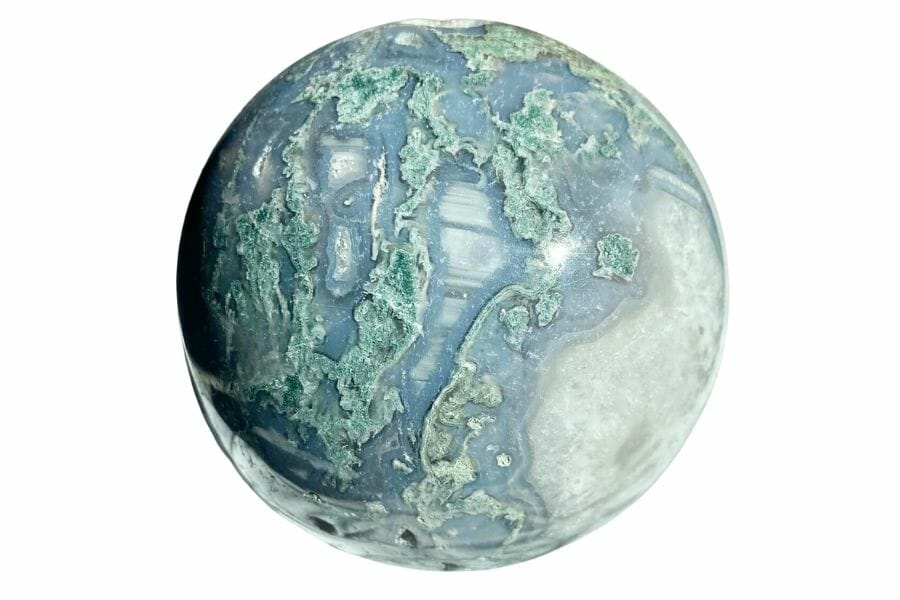Two minerals that often get people scratching their heads are tree agate and moss agate. It’s because they look so much alike! They also sound similar, and they do share many traits, but they also have their unique differences.
We’ll take a closer look at the physical characteristics of tree agate vs moss agate and how these factors can help in identifying each mineral. We’ll look at their color, patterns, crystal structure, where you can find them, and even the science behind how they form.
By understanding these shared traits, you’ll get to appreciate even more the beauty and intrigue that both tree agate and moss agate bring to the table.
Plus, we’ll give some practical tips on how to identify each one, so you won’t be left wondering next time you’re looking at a beautiful piece of agate jewelry or a raw agate specimen.
Tree Agate vs Moss Agate – The Major Differences
Although they share a name, these two agates are distinct in their appearance and formation. This article breaks down the differences, helping you differentiate between these two beautiful minerals.
Appearance – Moss agate can be translucent to opaque
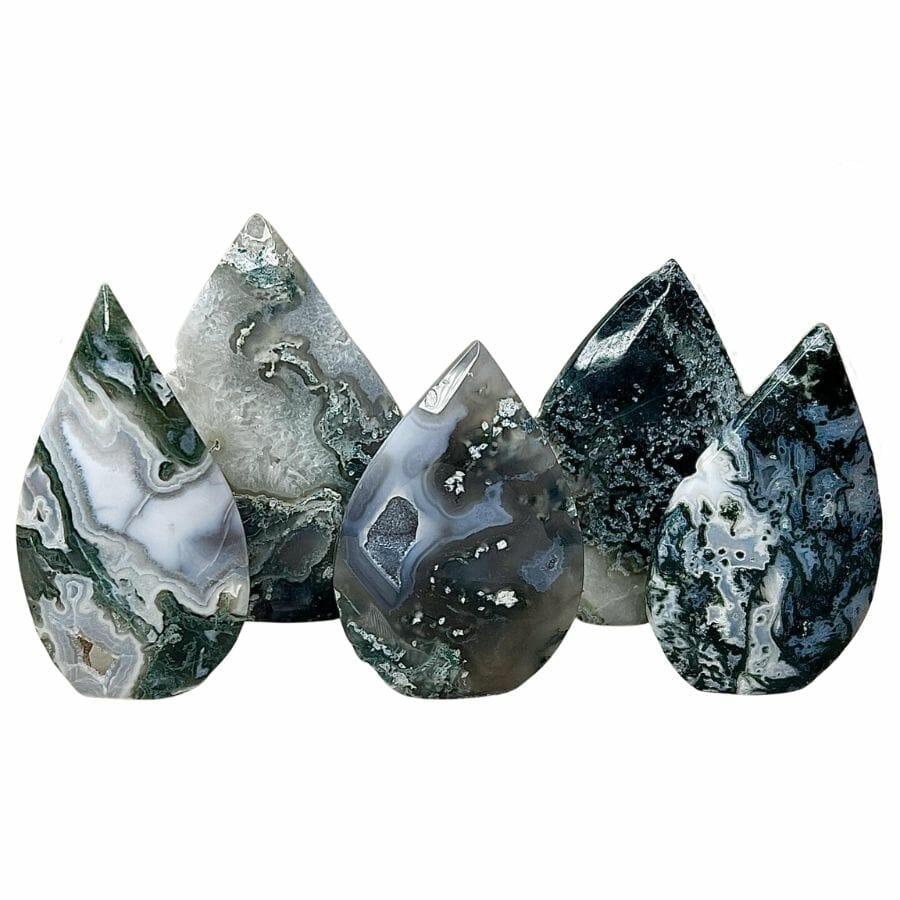
Mining for crystals can be a thrilling hobby, especially when you come across semi-precious stones like tree agate and moss agate. Because these two stones look so much alike, however, you’ll need to examine them closely to figure out which one is which.
Tree agate has patterns that can look like tiny tree branches or shrubs stretching across the stone. The patterns can vary from piece to piece, making each tree agate unique.
These patterns are often called “dendritic,” which describes things that look like trees or shrubs. That’s why tree agate is also known as dendritic agate.
Meanwhile, moss agate brings to mind a mossy forest floor or delicate ferns. The patterns in moss agate look like plant-like formations, scattered throughout the stone in a way that resembles a landscape. It’s like each stone holds a different scene from nature.
Another difference between these two stones is their transparency. Tree agate is mostly opaque, which means you can’t see through it.
Moss agate, however, can vary. Some pieces look opaque like tree agates, but others are translucent, which means some light can pass through them.
Colors – Tree agate generally comes with a white base and green patterns
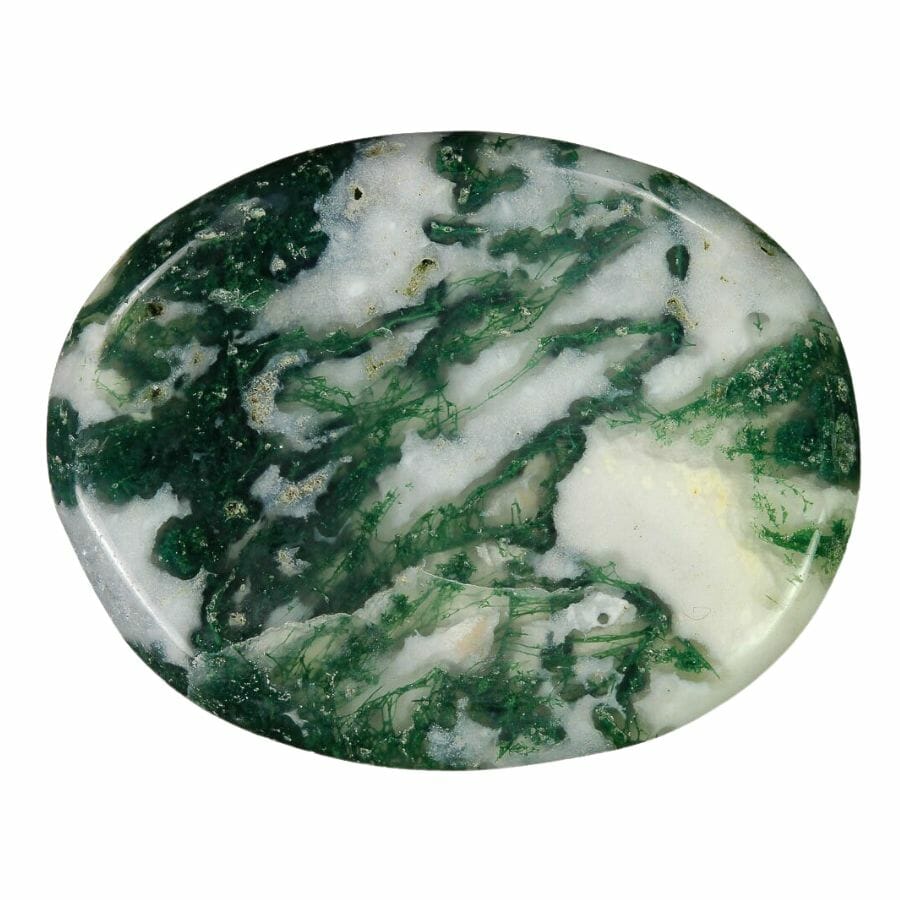
You’ll notice that color is a pretty obvious difference between tree agate and moss agate.
Tree agate has a mostly white or cream-colored base. It’s kind of like a blank canvas that’s been decorated with green patterns, making it look kind of like blue cheese.
The veins that form the stone patterns, meanwhile, typically come in shades of forest green.
Now, let’s talk about moss agate. This gemstone also has patterns that remind us of nature. But they don’t just stick to one color.
Its base can be translucent or milky white, but the inclusions – that’s what we call the patterns inside the stone – can be all sorts of colors. Most are green, like tree agate, but you can also find blue, red, or brown inclusions.
Luster – Moss agate has a glassy shine
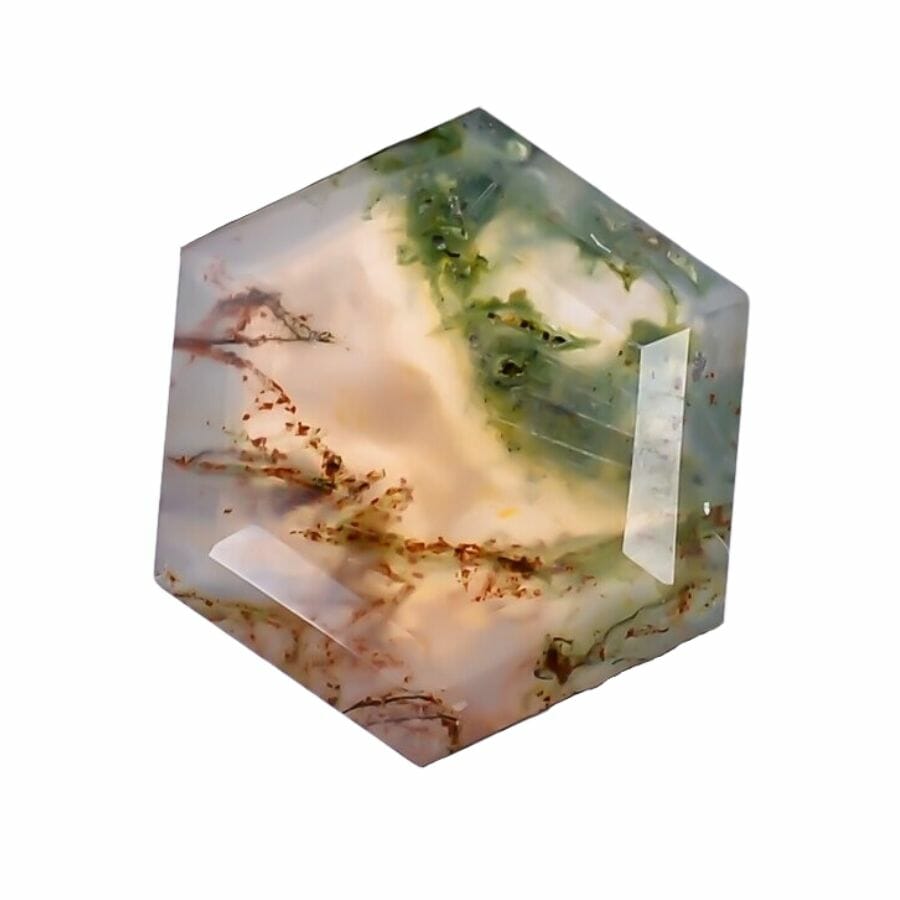
When we talk about the luster of a gemstone, we’re talking about how it interacts with light. In simpler terms, we’re talking about how its surface shines when polished. Tree agate and moss agate have different kinds of luster.
Tree agate has what we call a waxy luster. This means that it has a kind of soft glow to it, sort of like how the surface of a candle looks. When light hits a piece of tree agate, it doesn’t really sparkle. Instead, it has a nice, subtle shine.
Moss agate, on the other hand, has a vitreous luster. This kind of luster is like the shine you’d see on a piece of glass. When light hits a moss agate, it gives off a sharper, brighter shine than tree agate.
Chemical composition – Tree agate has traces of iron
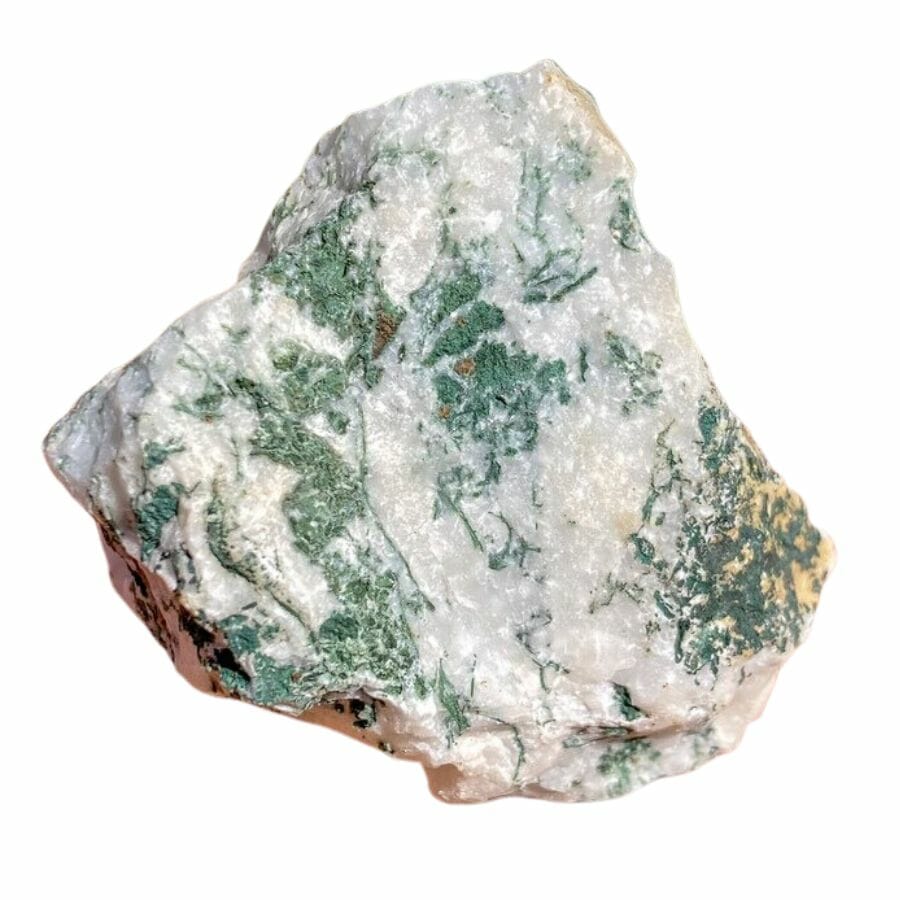
It can be difficult to differentiate moss agate vs tree agate because they’re made of the same stuff: silicon dioxide.
The cool thing is, even though tree agate and moss agate are made of the same stuff, they can look pretty different. This is because of tiny amounts of other elements that get mixed in with the silicon dioxide.
For tree agate, the green color usually comes from traces of iron. It’s like the gemstone had a little sprinkling of iron when it was being made.
Moss agate has more colors and this is also because of tiny amounts of other elements. The variety of colors in moss agate can come from traces of iron like in tree agate, but also from manganese or other minerals.
Location – Moss agate is found in Brazil, Uruguay, and Montana
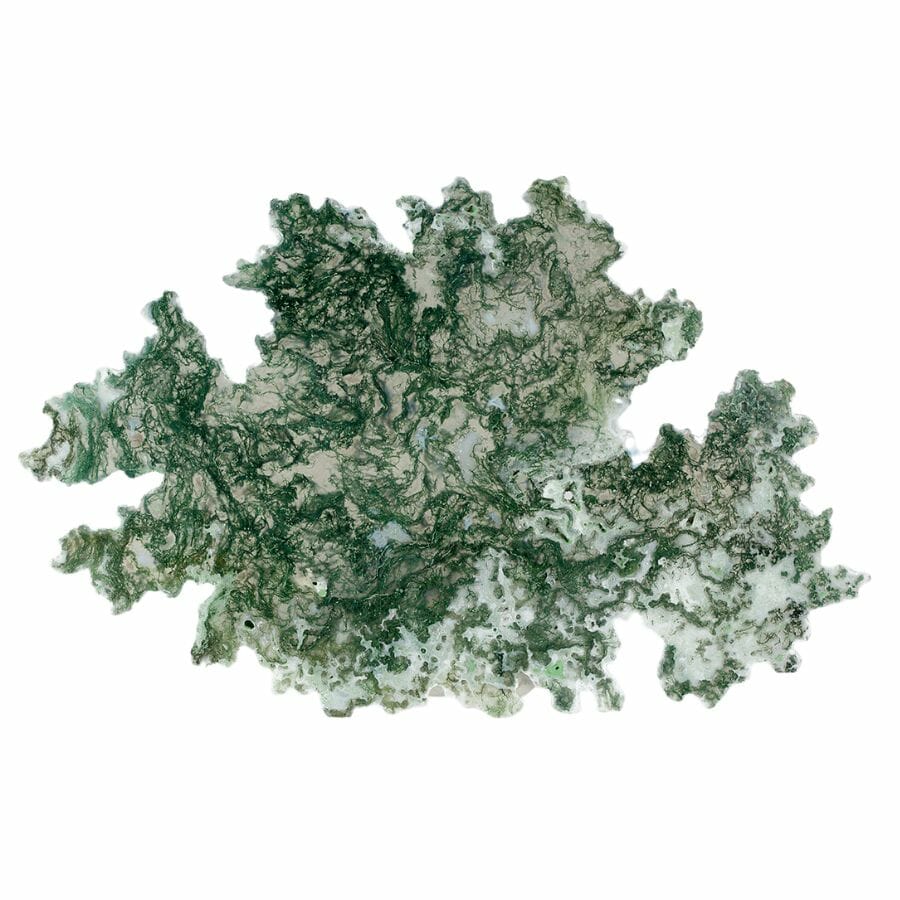
Tree agate and moss agate can be found in several different places around the world.
Tree agate is most commonly found in some pretty interesting locations. It can be found in Brazil, China, India, Australia, Kazakhstan, Madagascar, Mexico, Mongolia, Namibia, Uruguay, and even in the United States.
Moss agate is also found in lots of different countries. It’s found in India, Brazil, and Uruguay like tree agate, but also in some central European countries.
In the U.S., there’s a special type of moss agate called Montana moss agate. It’s found in the gravels of the Yellowstone River and its smaller rivers between Sidney and Billings, Montana. So, for those in Montana, going rock hunting near you could be a rewarding experience.
Moss Agate vs Tree Agate – The Similarities
Despite their unique characteristics, tree agate and moss agate share many similarities, which often lead to mix-ups. We’ll explore the common ground between these two minerals to help you understand why they’re so alike.
Streak – Both minerals have a white streak
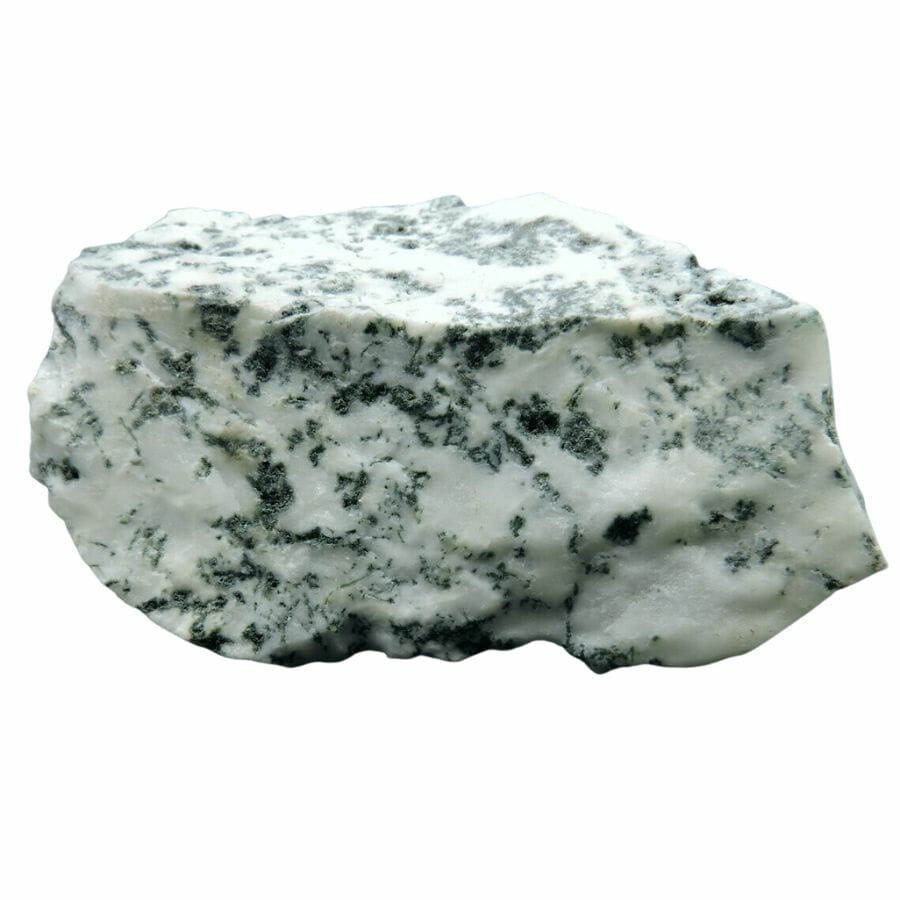
One of those similarities between tree agate and moss agate is their streak.
A gemstone’s streak is the color it leaves behind when you scratch it against a streak plate, kind of like a streak of chalk on a blackboard. Both tree agate and moss agate leave behind a white streak.
This is because tree agate and moss agate are both types of chalcedony, a kind of quartz that has tiny crystals. And quartz, no matter what colors it has inside, always leaves a white streak.
Hardness – They have a similar range of hardness
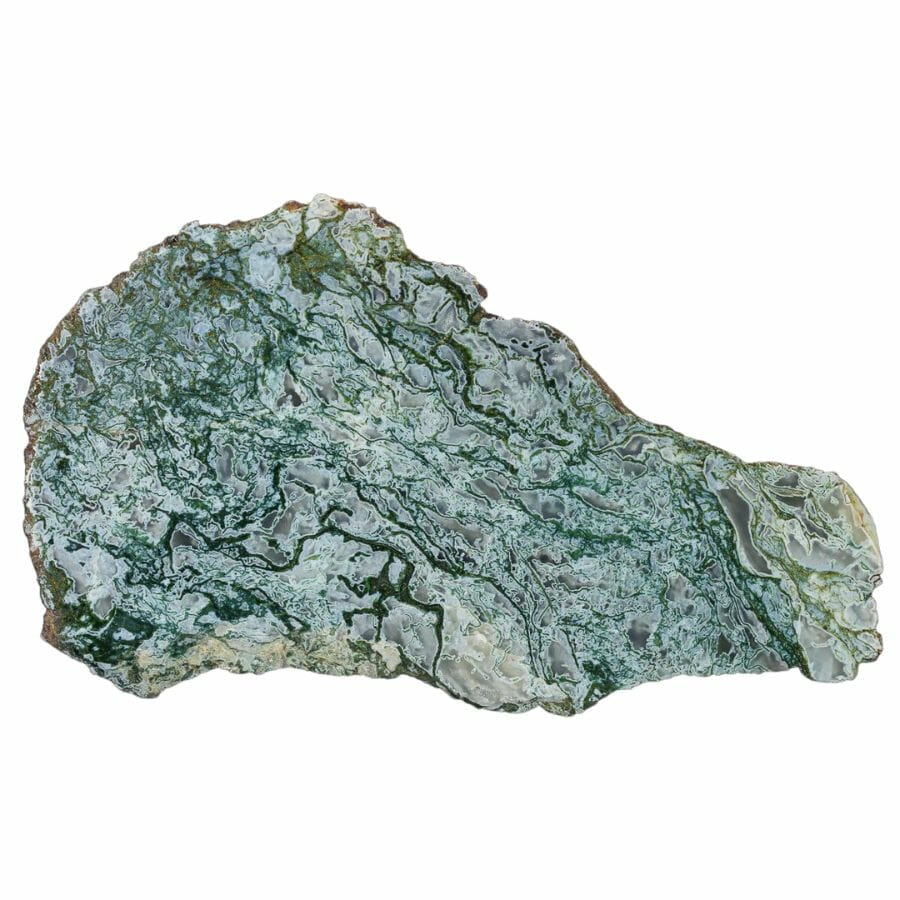
Hardness is one of the most important physical characteristics of a mineral. Basically, it tells us how easy or hard it is to scratch a gemstone.
When we talk about the hardness of gemstones, we use something called the Mohs scale. It’s kind of like a rating system for gemstones, where 1 is super soft, and 10 is as hard as a diamond.
Tree agate and moss agate might look different, but when it comes to hardness, they’re pretty similar. Both minerals rank at around 6.5 to 7 on the Mohs scale. This means they’re fairly hard and can resist scratches pretty well.
Because of their hardness, both tree agate and moss agate are great for making jewelry and other decorative objects. They’re not only beautiful, but they can also stand up to moderate wear and tear.
Formation – The two minerals form in the same way
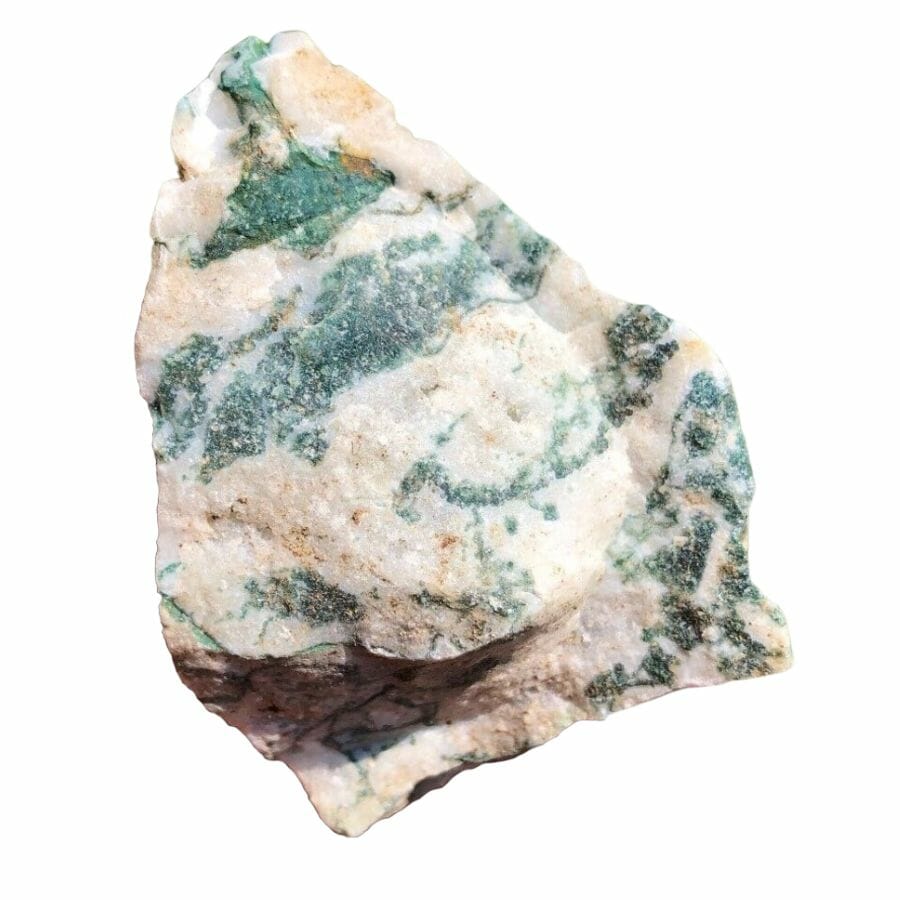
Tree agate and moss agate start out as a kind of silicon dioxide “soup.” This soup can fill in small spaces in different types of rock, from sedimentary rocks like limestone to volcanic rocks like basalt.
As the soup starts to cool down and solidify, amazing things happen. In tree agate, iron-rich materials start to form tree-like patterns, which we know as dendrites. The patterns can look like tiny forests trapped inside the stone.
Moss agate goes through a similar process. But instead of forming tree-like patterns, the impurities in the soup form patterns that look more like moss or ferns.
Density – Both have similar densities
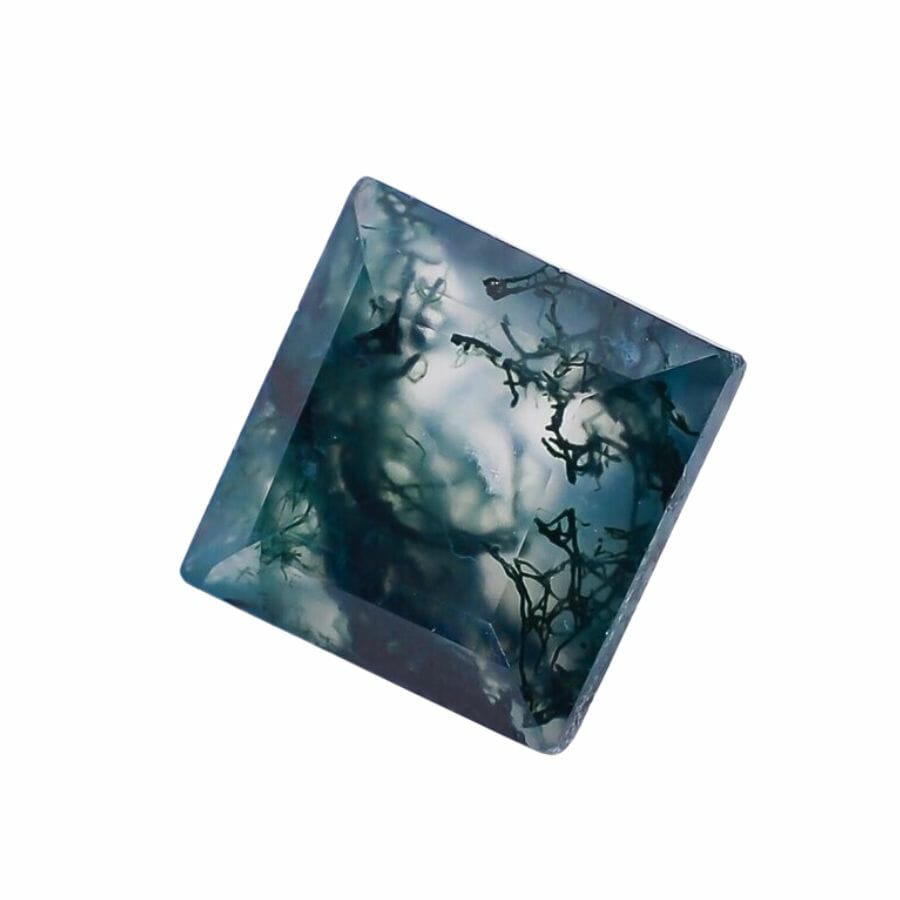
A mineral’s density is how much mass it has in a certain volume. It’s measured in grams per cubic centimeter (g/cm3).
Tree agate and moss agate both have a density of around 2.58 to 2.64 g/cm3. This means that if you had a cube of tree agate or moss agate that was one centimeter on each side, it would weigh about 2.58 to 2.64 grams.
Because they have the same quartz composition, tree agate and moss agate have a similar weight and feel when you hold them. So, if you were to close your eyes and hold a piece of tree agate in one hand and a piece of moss agate in the other, they would feel about the same weight.
Crystal structure – The two are made of microscopic crystals
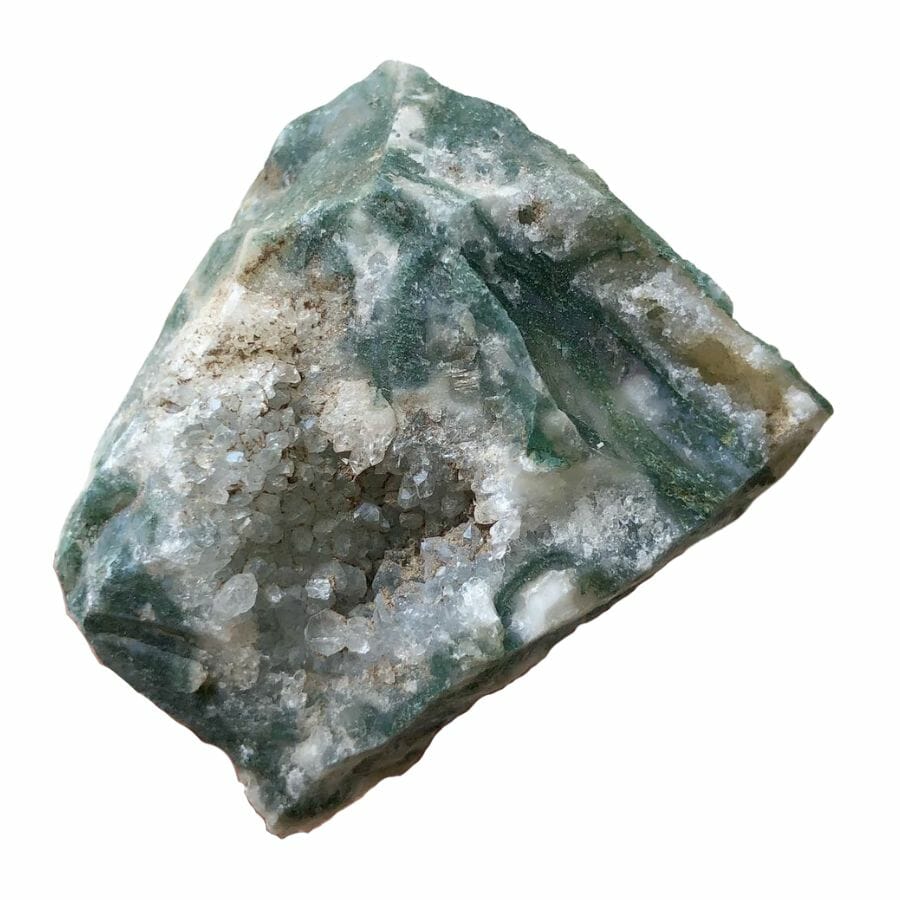
If you were to look at a mineral under a really powerful microscope, you’d see that it’s made up of tiny crystals. And different types of minerals have different shapes of crystals.
Let’s talk about tree agate and moss agate. Both of these minerals have a type of crystal structure that’s described as trigonal. This means that the tiny crystals inside them are shaped like three-sided pyramids.
Tree agate and moss agate are what scientists call cryptocrystalline. This means that the crystals in them are so small, you’ll need a high-powered microscope to see them. But even though you can’t see the crystals, they’re still there, giving the gemstones their shape and properties.
So, although they look different to the naked eye, on a microscopic level, tree agate and moss agate have the same kind of crystal structure!
Cleavage – Both fracture instead of cleave
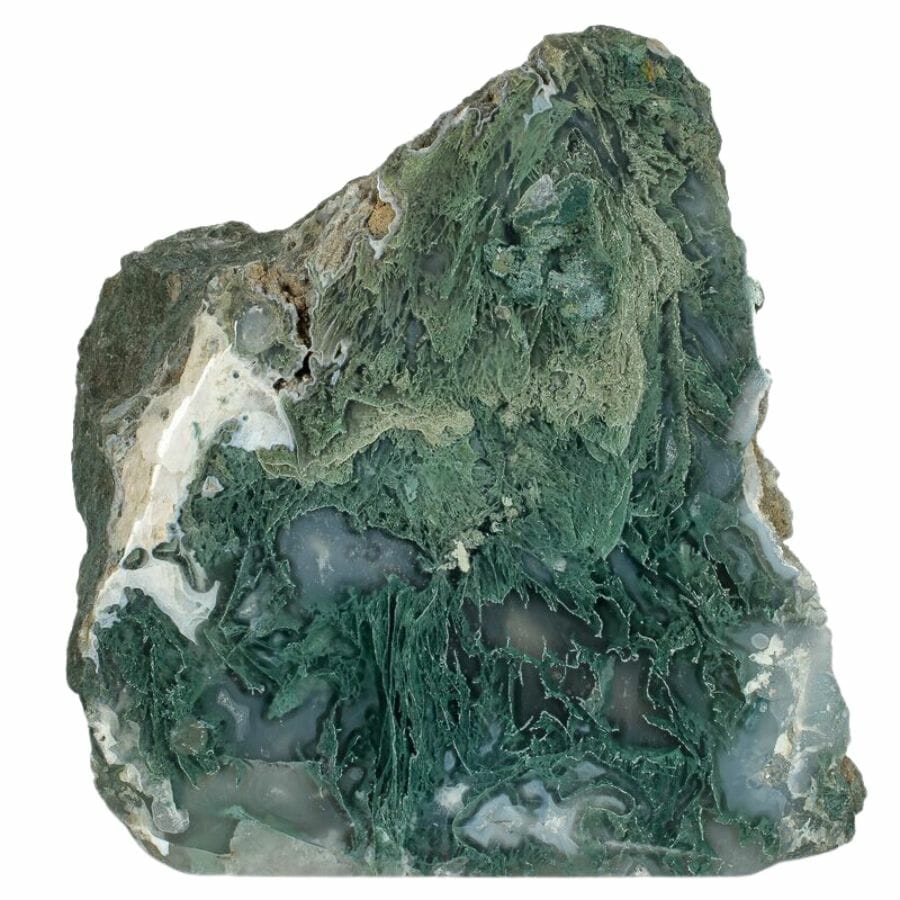
In the world of geology, cleavage refers to how a mineral breaks. Some minerals split neatly along flat planes, kind of like how a piece of wood splits along the grain. But that’s not the case for all minerals.
Take tree agate and moss agate, for example. They don’t have what we call “true cleavage.” That means they don’t break along flat, smooth planes. Instead, they break into a conchoidal fracture.
Conchoidal fractures are curved surfaces that look a bit like the inside of a clamshell.
Both tree agate and moss agate break this way because of their crystal structure. Remember, they’re made of tiny crystals of quartz. And quartz, no matter how small the crystals, always breaks into a conchoidal fracture.
Magnetism – Neither one is magnetic
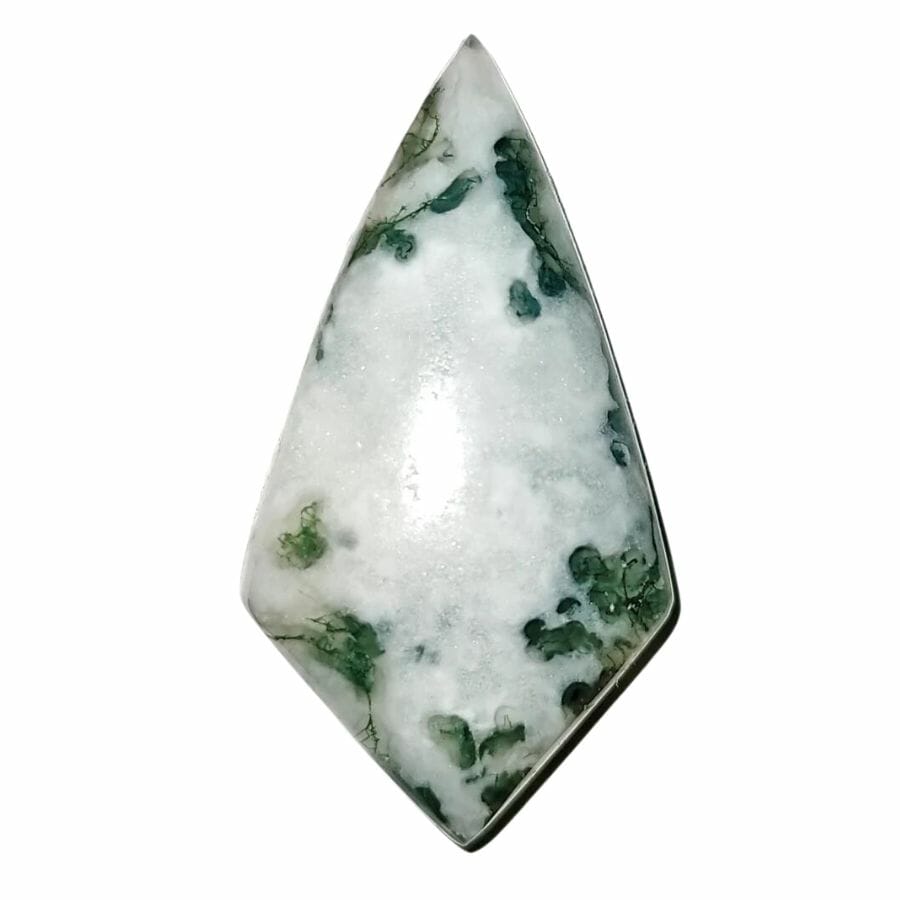
Both tree agate and moss agate are non-metallic minerals, so they aren’t magnetic. In other words, they’re not attracted to magnets, and you can’t effectively make them into magnets either.
Scientists have a word for this. They call these kinds of materials “diamagnetic.”
Diamagnetic materials are pretty interesting. Even though they’re not attracted to magnets, they can do something else that’s pretty cool. If you put them in a really strong magnetic field, they’ll create their own tiny magnetic field that goes in the opposite direction.
However, this effect is so weak that you wouldn’t notice it in everyday life.
Fluorescence – The two minerals don’t fluoresce
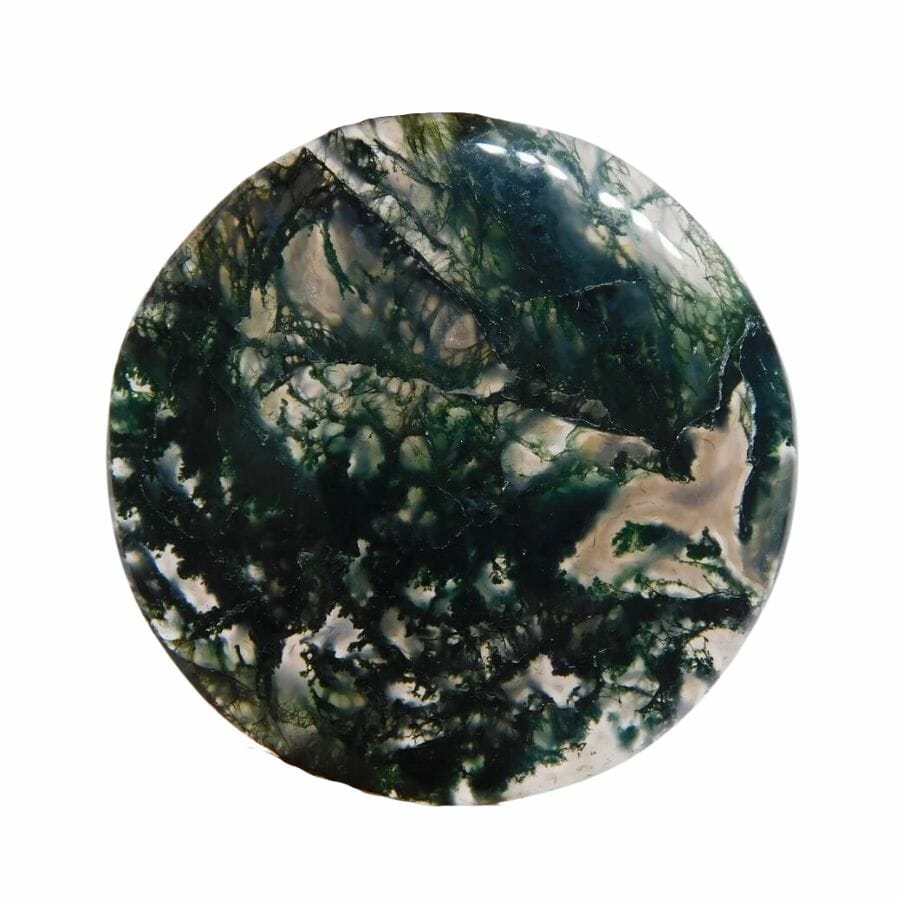
Some minerals can glow under ultraviolet (UV) light. This is what’s called fluorescence. However, not all minerals can do this.
Take tree agate and moss agate, for example. If you were to shine a UV light on them, they wouldn’t glow. Most agates, including these two, don’t react to UV light at all.
Conductivity – Neither mineral can conduct electricity
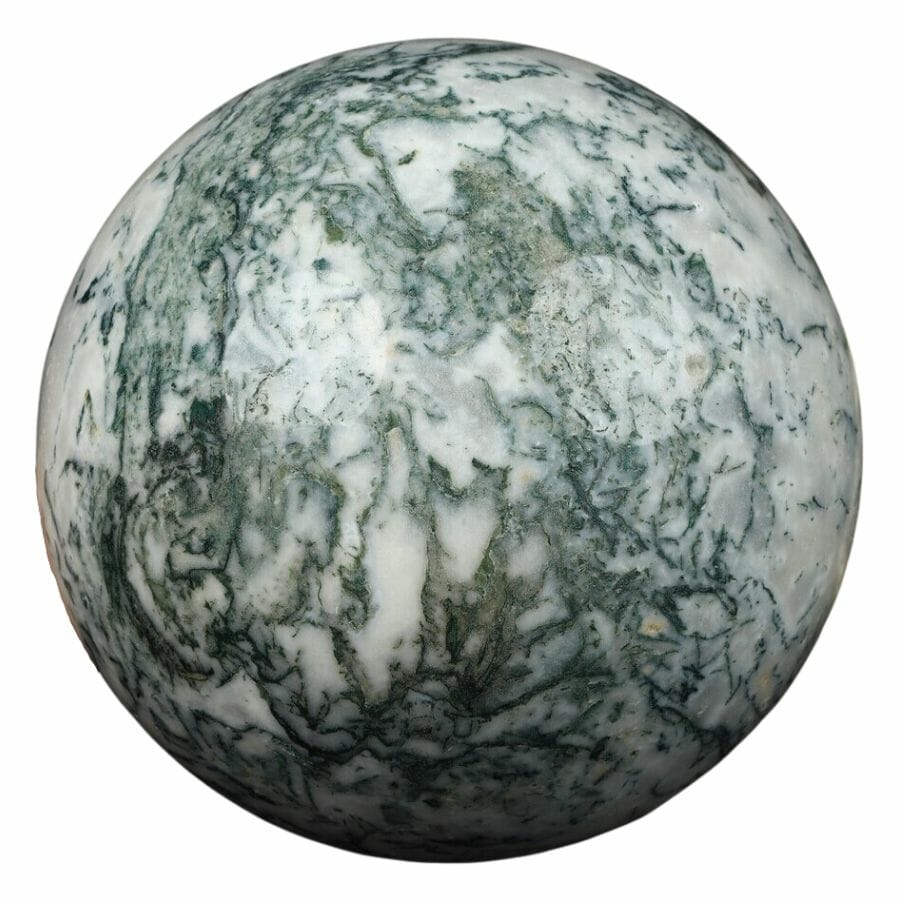
Tree agate and moss agate are very similar when it comes to how well they can conduct electricity, which is not very well at all!
This is because both of these minerals are made of silicon dioxide. Silicon dioxide is what we call an insulator. That means that it’s really bad at letting electricity move through it.
Think about when you have to untangle a mess of cords for your electronics. It’s a pain, right? But you don’t get shocked while doing it. That’s because the cords are covered in a layer of insulating material that stops electricity from getting out.
Price – Both cost roughly the same
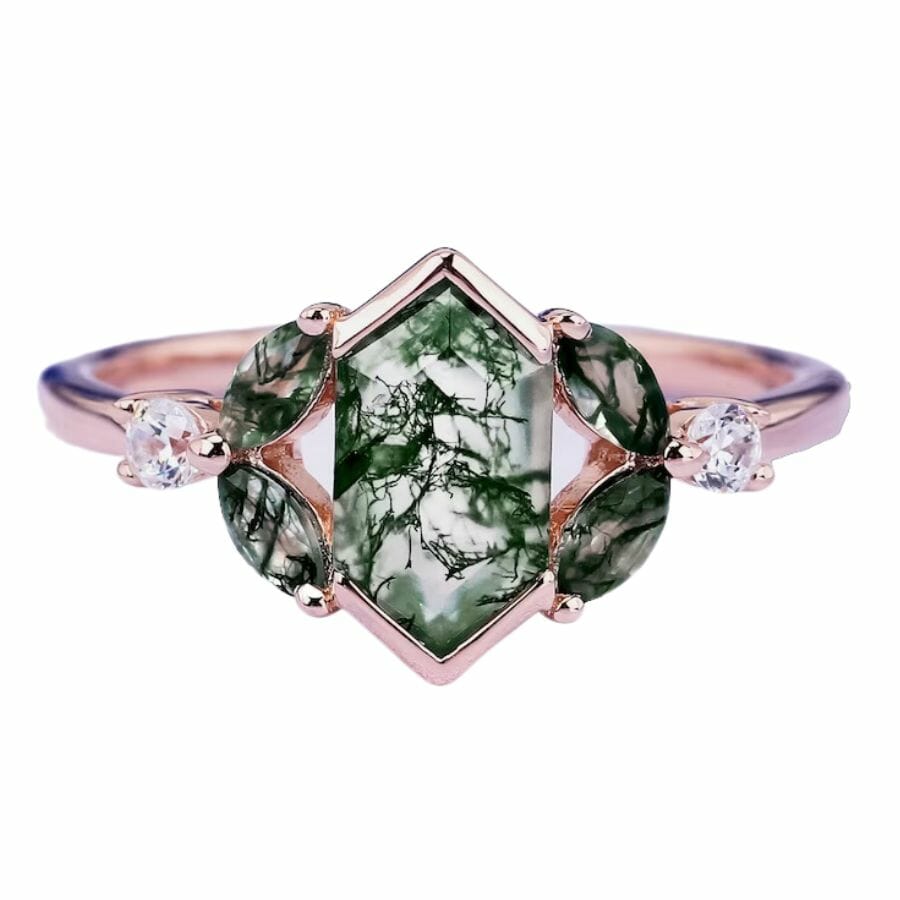
The price of tree agate and moss agate are pretty similar. They’re what we call semi-precious stones, which means they’re more affordable than some other types of gems.
How much they cost can depend on a few things. Factors like how big the stone is, how good its quality is, and whether it has really cool patterns can all affect the price.
Even though the price can change based on those things, both tree agate and moss agate usually cost about the same. So whether you’re buying a piece of jewelry or a neat rock for your collection, either of these agates could be a good choice.
They also won’t break the bank, and they both have their own unique styles that make them cool to own. Whether you choose tree agate or moss agate, you’re getting something special without having to spend a ton of money.
The Easiest Ways to Tell Tree Agate and Moss Agate Apart
Tree agate and moss agate can look pretty similar. They’re both types of chalcedony, and they both have cool patterns inside them. But there are a few simple ways to tell tree agate vs moss agate.
Look at the stone’s patterns
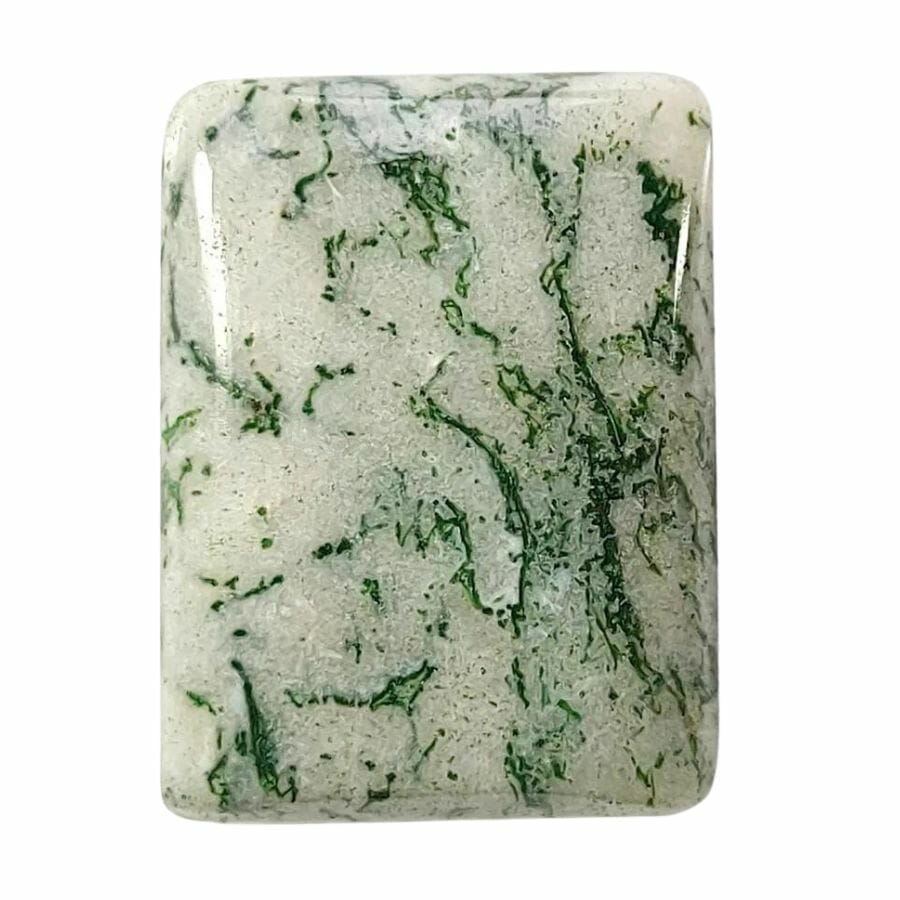
Think about a time when you were in a park. Remember the way the trees branch out with their many arms reaching toward the sky? Well, if you’re holding a stone that has similar patterns, it’s probably a tree agate.
The patterns inside this stone often look like tree branches or shrubs. These patterns usually have a darker green color, and they stand out against the stone’s white or cream base.
Now, let’s take a trip to a different part of the park – the mossy forest floor. If your stone has patterns that look like moss or ferns, then you’re probably holding a moss agate.
Moss agate’s patterns can also come in a few different colors, like green, blue, red, and brown. They’re found within a translucent or milky white base. This means that unlike a tree agate’s base, a moss agate’s base can sometimes be a little see-through.
Check the stone’s clarity
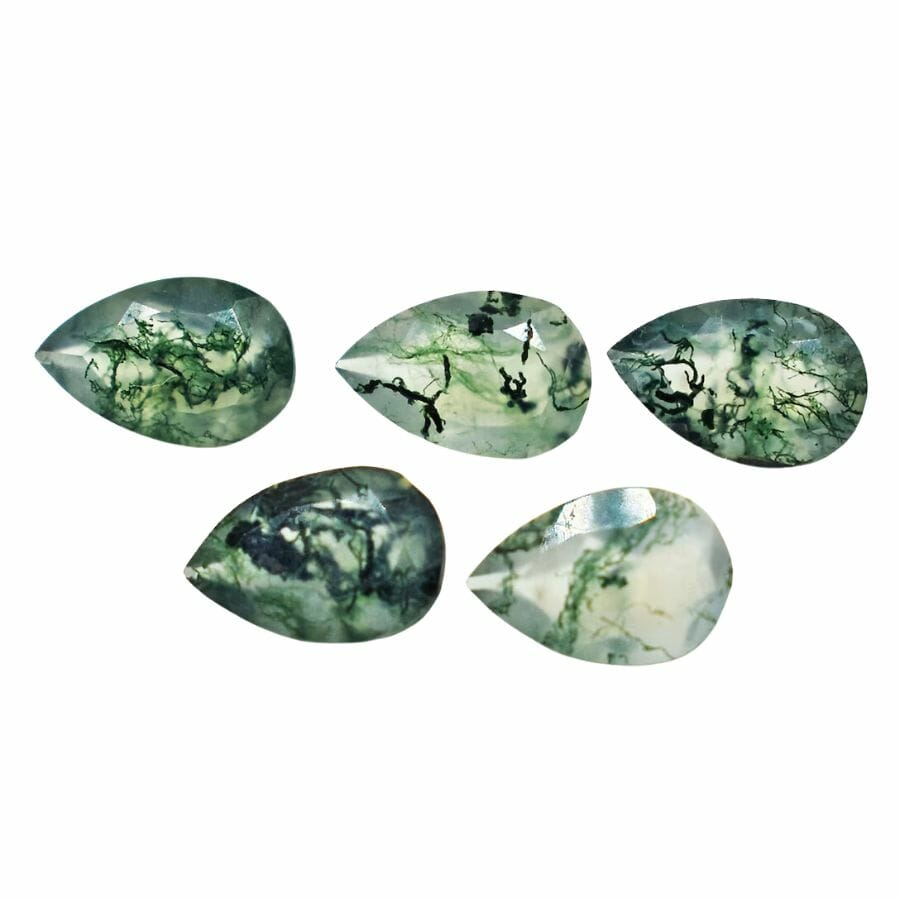
A good clue to consider is how clearly you can see through a stone that could be tree agate or moss agate. Tree agate is generally opaque; you can’t see through it at all. If you hold it up to the light, it will likely just block the light out.
Moss agate, on the other hand, is generally translucent. This means that if you hold it up to the light, some of that light might sneak its way through the stone. But remember, moss agate can also have opaque parts.

